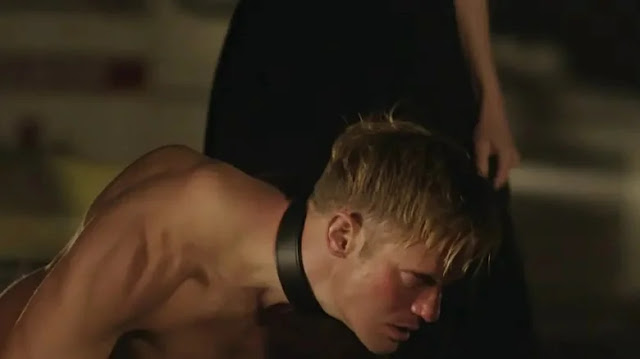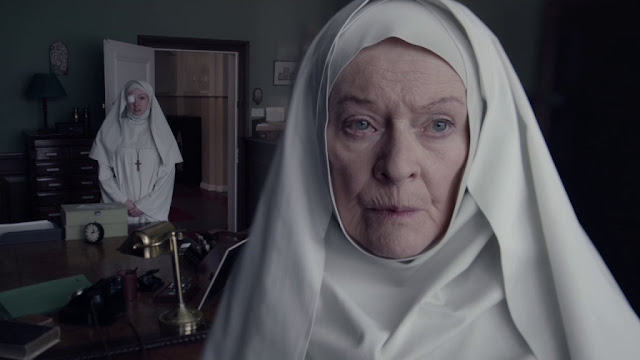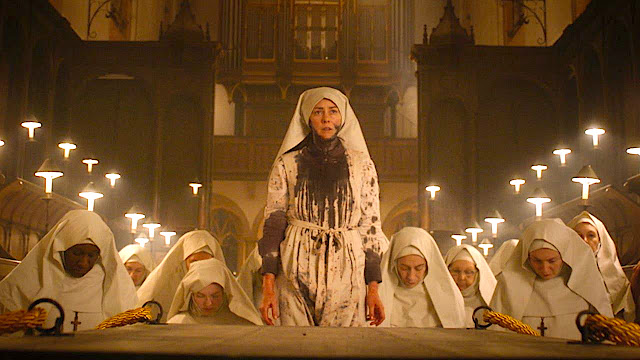Nocebo (Lorcan Finnegan, 2022) even manages to make Eva Green ugly! Hard to do.
Many people do not take horror films seriously, and just think they are dumb fun without anything really socially relevant to say. Further, those kinds of films rarely get Oscars, which isn't the only way to judge a film, but it is a way many people align films with their worth. Sigh. Sure, some films are more overt about their socially conscious message, but horror films have important things to say about our fears and anxieties, as well as how those fears shape our world. Most horror makes us fear through the process of "othering," rendering characters who might seem different and strange as monstrous. Nocebo, Lorcan Finnegan's newest film after Vivarium (2019) goes back to his Folk Horror focus, initially represented in his first feature Without Name (2016). While I haven't seen either of his previous films, a film starring Eva Green will always be in my "to see" list, especially if it's a Folk Horror film. Win!!! Finnegan's film is an astute exploration of inequality and revenge, and once you get to film's end, the message is damn clear. viewers should be thinking more deeply about where their clothing comes from, and who makes them...but I'm getting ahead of myself.
Traditional medicine seems to fail Christine, for her symptoms disappear every time she sees a doctorThe film is set in both Ireland and the Philippines, making this work a solid coproduction. Spectators are first introduced to Christine (Eva Green) while she's at work. She's a children's fashion designer, and she's putting on a runway show for her latest designs. Having to take a phone call, we only see her side of the conversation, but she appears deeply upset and says "pulling out bodies" at one point. Ruh-roh. My first thought was that either her husband, Felix (Mark Strong) or her daughter Roberta, aka Bobs (Billie Gadsdon), have been in a car accident. This narrative move seems to be more and more common in horror films with female protagonists. While Christine is on the phone, a mangy looking dog walks into the showroom, and slowly shakes itself all over Christine, showering her with ticks. Yeah, it's nasty, but we never learn what the phone call is about until much, much later. Cut to eight months later, and Christine is a shadow of her former self, with a mysterious ailment that she cannot seem to shake. Her symptoms weirdly disappear every time she goes to the doctor, and thus Felix thinks it's all in her head--of course he does, because the unsupportive and suspicious spouse is the go-to in horror films that focus on women protagonists. Then her savior arrives, the lovely and enigmatic Diana (Chai Fonacier). Because of Christine's frequent memory lapses, she's not at all phased that she has forgotten she's hired Diana, a Filipino woman, to take care of the house and her daughter.
Diana (Chai Fonacier) employs folk practices to help heal Christine's various ailmentsChai Fonacier as Diana is a force of nature in Nocebo, literally and figuratively. She arrives, claiming to be there to help Christine, and she does so, using various folk traditions and practices to pull the sickness out of her. She's a bit mysterious, though, with a shrine set up in her bedroom that she hides away from her employers, and a pile of ash that she leaves in front of her bedroom door--one that a child's footprints are nestled in. Christine grows more dependent on Diana as time passes, and even Bobs becomes increasingly close to her gentle kindness. Yet, what is she hiding? Certainly Felix is extremely suspicious, and feels like he's in an emotional tug of war with her over Christine's well being.
Diana, as a child, being possessed by the Ongo--one that gives her great powersDiana eventually discloses to Christine that her healing powers come from her possession by an Ongo, whose powers were passed to her as a young girl when the Ongo originally passed in her childhood home. Now, Diana has the ability to heal, and to also cause great harm. Like any good Folk Horror, the cultural clash between this rich, white, privileged family and a poor woman of color struggling to make money determines much of the film's conflict. Viewers discover later, through flashbacks to the Philippines, that Diana used to work in sweatshop eking out fast fashion in a Philippine city, and her daughter, who she was forced to bring to work with her, perished when a fire erupted in the warehouse. Crucially, **spoilers moving forward, Diana was making clothing, children's clothing, for Christine. Once viewers think back to the film's instigating incident, and the start of Christine's mysterious illness, the urgent phone call she takes at her fashion show is news of her workers perishing in this fire. They were harmed because they were 1) forced to work in unsafe conditions, 2) asked to increase their quota of garments significantly, and 3) locked into the building in order to prevent them from stealing--something that Christine specifically makes a policy. Diana's long game is revenge.
Diana's rituals escalate as she "helps" Christine to understand her complicity in her daughter's deathChristine's husband Felix was suspicious of Diana from the start, but Diana expertly uses Bobs as a way to cast doubt on his trustworthiness, asking her to lie in order to turn Christine against him. Then a fortuitous fall over the bannister lands Felix in the hospital, and Diana conveniently steps up her treatment of Christine's illness, including having her slave over a sewing machine in intense heat and without breaks. While I'm not going to give a way the film's ending, it's pretty damn satisfying.
Bobs, as the new Ongo, collects valuable herbs in the forest





































